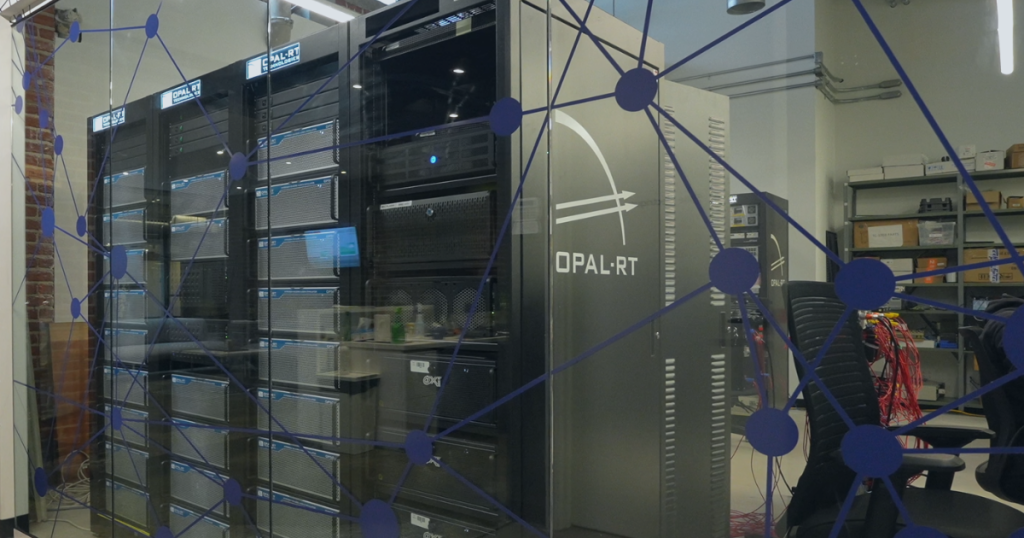9 roles and responsibilities of a data center commissioning engineer
Simulation
10 / 15 / 2025

Key Takeaways
- Data center commissioning engineers ensure reliability by verifying that every system performs exactly as designed before operational handover.
- Early planning, scope definition, and coordination among design, construction, and operations teams prevent rework and protect project timelines.
- Testing provides measurable proof of system safety, resilience, and compliance under real conditions.
- Detailed documentation and change management preserve integrity across audits, maintenance, and future upgrades.
- Real-time simulation from OPAL-RT helps engineers validate complex systems safely, improving test accuracy and reducing on-site risks.
Uptime is not a hope; it is engineered through disciplined commissioning.
Every megawatt, every valve, and every line of control logic must be proven before go live. Commissioning turns drawings into tested performance, reduces risk, and builds confidence. The person steering this work is the commissioning engineer who connects design intent to facility operation.
Teams look to this role for crisp plans, field leadership, and evidence that systems are ready. Schedule pressure never goes away, so your process must be repeatable, measurable, and traceable. Clear priorities help you plan early scope, deliver integrated tests, and hand off cleanly. Use these practices to protect uptime, accelerate learning across teams, and reduce surprises.
Understanding what a data center commissioning engineer really does

A data center commissioning engineer sets the standard for how a facility proves readiness before load moves in. This professional aligns design requirements with field conditions, then verifies that construction and controls deliver the expected performance. You plan the path from submittal reviews and factory tests to integrated exercises under realistic scenarios. You also act as a neutral voice who converts technical details into clear acceptance criteria for owners, designers, and operations.
Daily work covers far more than checklists and punch items. You judge risk, choose test sequences, and confirm that protections, interlocks, and failovers behave correctly. You record evidence, issue findings, and help teams correct issues without disrupting schedule or safety. The goal is simple, measured reliability that holds up during maintenance, faults, and growth.
Why data center commissioning and testing are essential for reliability
Data center commissioning gives owners confidence that equipment and controls meet the intended design, not just on paper but under operating conditions. Early verification catches wiring mistakes, setpoint mismatches, and sequence gaps before they turn into outages. Structured procedures also shorten learning curves for operations staff, which cuts the chance of process errors during handover. A solid commissioning approach reduces lifetime cost by addressing root causes before they become recurring incidents.
Data center testing complements this work by proving how systems respond to events that matter most, including utility loss, generator start, and cooling transitions. You validate time to ride through, breaker coordination, and restart behaviour after faults. You also confirm alarms, trending, and reporting so operators can act on timely, accurate information. That combination builds trustworthy capacity planning, safer maintenance windows, and clear compliance evidence.
9 key responsibilities every data center commissioning engineer must manage
A successful facility rests on steady processes that reduce unknowns and guide teams through complex builds. Owners expect structured testing that explains risks plainly, aligns stakeholders, and records defensible results. Engineers who master communication, documentation, and test rigour protect both schedule and safety. Clear scope, transparent methods, and repeatable practices set the tone for the whole project.
1. Planning and defining commissioning scope and objectives
Strong scope definition keeps effort focused and prevents hidden work from derailing timelines. A data center commissioning engineer documents systems in scope, acceptance criteria, pass or fail thresholds, and required evidence. You define witness requirements, planned outages, and constraints so trades can prepare properly. This clarity helps the owner measure progress and understand what “ready” actually means.
Objectives should tie directly to availability targets, energy goals, and operational needs. Scope also reflects phases, from component checks to integrated system tests with simulated faults. Good planning balances thoroughness with constructability, so tests fit the build sequence and site access limits. The outcome is a shared understanding that keeps cost, quality, and schedule aligned.
2. Coordinating between design, construction, and operations teams

Misalignment between drawings, installed equipment, and operating procedures creates real risk. You serve as the connective tissue across design consultants, contractors, vendors, and operations. This involves structured meetings, clear action logs, and timely decisions on changes that affect testing. A data center commissioning engineer maintains impartiality and keeps conversations tied to measurable outcomes.
Effective coordination includes early workshops to confirm sequences, interlocks, and naming conventions. You ensure controls points are exposed, trend lists are built, and setpoints are versioned. Field constraints get addressed before test week so lifts, access paths, and permits do not stall activity. These habits prevent last‑minute scrambles and protect critical milestones.
3. Developing detailed commissioning and testing plans
A written plan translates scope into steps the field can execute safely. It lists prerequisites, safety measures, instruments, expected results, and restoration actions after each test. You include diagrams, tag references, and forms so technicians know exactly what to check and record. That level of detail reduces ambiguity and improves repeatability across shifts and phases.
Good plans model operational scenarios, not just component checks. Think utility switchover, chilled water mode changes, and load ramps with staged events. Plans also address communication protocols, alarm priorities, and data retention so monitoring systems support operations from day one. Careful planning sets up credible, auditable results that stand up to owner review.
A written plan translates scope into steps the field can execute safely.
4. Overseeing system integration and equipment verification
Equipment rarely fails alone; interactions create the most surprising faults. You verify that upstream protections, downstream loads, and control logic work as a whole. This includes confirming permissives, interlocks, and timers across power, cooling, and life safety systems. A data center commissioning engineer documents behaviour during transitions, not just steady state.
Verification extends to vendor packages and field terminations, including control wiring and network links. You check nomenclature consistency, graphics accuracy, and alarm routing across building and electrical monitoring. Load steps and mode changes reveal sequencing errors that static checks miss. Closing these gaps early prevents nuisance trips and false confidence.
5. Managing power and cooling system validation
Power system checks confirm UPS performance, generator start sequences, breaker settings, and grounding continuity. You test transfer times, ride‑through capacity, and selective coordination to protect downstream loads. Cooling validation examines pump curves, valve positions, airflow balance, and setpoint stability across operating modes. These tests provide evidence that capacity claims hold under expected loads.
Data centre reliability hinges on how power and cooling respond to change, not just nameplate ratings. You validate restart sequences, verify emergency stops, and confirm that controls maintain safe boundaries during swings. Results help operations choose maintenance windows with less risk and plan growth with facts. Solid validation also supports energy targets through stable control and correct instrumentation.
6. Conducting functional performance and reliability tests

Functional performance tests prove that sequences accomplish the intended outcome. You script events, record time stamps, and compare results to criteria for pass or fail. Edge cases matter, so tests include sensor failures, control loss, and manual overrides. A data center commissioning engineer ensures each outcome is traceable to written requirements.
Reliability testing exercises systems under stress without placing the facility at risk. This can include longer load runs, repeated transfers, and mode changes with varied starting conditions. Patterns in the data reveal hidden weaknesses and inform setpoint adjustments. The goal is stable, predictable operation over the full range of expected conditions.
7. Ensuring documentation accuracy and regulatory compliance
Paperwork proves what happened, how it was measured, and who witnessed the results. You maintain version control, signoffs, and calibration certificates for instruments used during testing. Forms capture readings, observations, and deviations, then tie those records to system IDs and dates. Clear documentation prevents rework and supports audits long after turnover.
Compliance requirements guide many acceptance criteria and retention timelines. You reference applicable codes, standards, and owner policies within test plans and reports. Accurate naming, labelling, and as‑built updates reduce confusion during maintenance or future upgrades. Consistency across documents helps operations find answers quickly when time is tight.
8. Identifying and resolving design or operational issues early
Early issue discovery saves time and money later in the project. You look for inconsistent sequences, missing interlocks, and conflicting setpoints during submittal reviews. Field walks reveal clearance problems, service access constraints, and sensor placement concerns. A data center commissioning engineer records these findings and drives them to closure.
Resolution means more than marking items as complete. You re‑test corrected items, validate upstream and downstream effects, and update documents. Lessons learned feed back into later phases so similar issues do not repeat. This continuous feedback loop boosts quality without slowing progress.
9. Delivering post‑commissioning training and turnover documentation
The job ends with a facility that operators can run with confidence. Training should map directly to tested sequences, alarm responses, and routine procedures. You provide scenario‑based sessions, concise guides, and contact paths for follow‑up questions. Turnover packages include reports, drawings, firmware versions, and checklists that match the as‑built state.
Good handover strengthens safety and shortens time to steady operations. Operators gain context for alarms, data trends, and maintenance tasks. Clear records help future projects interface with existing systems without guesswork. Owners get a consistent foundation for audits, upgrades, and capacity changes.
A commissioning program that follows these responsibilities produces reliable capacity that teams can trust. People understand how systems behave, what to watch, and when to act. Evidence is organized, current, and usable during day‑to‑day operations. That is how facilities avoid surprises and sustain uptime as they expand.
How data center testing supports safe system operation and compliance
Testing provides proof that safety controls and protective logic do what they should under stress. Teams confirm safe states, time coordination, and alarm visibility before production loads arrive. The process also validates operator procedures that guide responses to failures and maintenance. Good testing replaces assumptions with measured performance that holds up during audits.
Owners need testing that demonstrates safe isolation, controlled restart, and accurate monitoring. Results inform how to stage maintenance tasks and how to recover from faults without adding risk. Clear evidence gives regulators and insurers confidence in the facility’s controls, documentation, and training. Data centre operators gain consistent playbooks and faster incident response.
Electrical safety and protective device coordination
Electrical testing confirms that protective devices act in the right order and time window. You verify instrument transformer polarity, relay settings, and breaker trip curves under expected fault levels. Transfer sequences are timed and compared to criteria so essential loads remain supplied. Results guide setpoint tuning and confirm that nuisance trips are not hiding a coordination gap.
Protection does not stop at one panel or one relay. Testing follows the path from sources to loads so upstream and downstream devices act as a coordinated system. Operators gain clear fault expectations and safe switching procedures backed by measured timings. That clarity reduces risk during maintenance, energization, and emergency conditions.
Control software validation and change management
Control logic sits at the centre of safe operation. Testing confirms that building management, electrical monitoring, and local controllers share the same naming, scaling, and priorities. Alarm routing, trend intervals, and failback modes are verified against documented sequences. Results expose gaps that paper reviews rarely catch.
Change control keeps that assurance intact over time. You capture versions, backup images, and signoffs before and after changes. Test cases are replayed to confirm no drift from approved behaviour, then results are archived. This discipline protects uptime without freezing progress on improvements.
Operational readiness for power and cooling sequences
Testing shows how power and cooling respond when conditions shift. You validate startup and shutdown orders, interlocks across utilities, and safe restoration after faults. Cooling tests confirm stable temperatures, pressure balance, and valve authority through mode changes. Operators see how to move between states without crossing safety boundaries.
Integrated drills reveal if procedures, tools, and staffing match the facility’s needs. Crew handoffs, radio calls, and escalation paths get tested, timed, and refined. Training plans are adjusted using what the drills expose, then retested for closure. These cycles build muscle memory and shorten response during real events.
Standards alignment and audit evidence
Compliance often requires more than a signature. Testing packages show methods, instruments, pass or fail thresholds, and witness details. Calibrations, as‑builts, and setpoint lists get linked to system IDs for traceability. Auditors can track what changed, when it changed, and why it changed.
Well‑structured evidence also helps during internal reviews and insurance assessments. Teams answer questions with data instead of recollection, which speeds approvals. Documentation remains useful during future upgrades and expansions, not just at handover. That continuity protects safety and reliability long after the first tests finish.
Testing and compliance go hand in hand when records, findings, and corrections stay current. Operators benefit from clear procedures shaped by measured results, not assumptions. Owners gain better risk profiles and fewer surprises during inspections or renewals. Safety becomes daily practice supported by repeatable tests and tidy evidence.
How OPAL-RT helps engineers strengthen data center testing and validation

OPAL-RT provides real-time digital simulators that let teams exercise power and control logic before, during, and after site testing. Engineers model electrical networks, generators, and UPS behaviour, then drive controllers with realistic signals. Hardware-in-the-loop (HIL) methods expose edge cases that field windows rarely allow, such as rare transfer chains or multiple concurrent faults. Teams arrive on site with sequences proven against measured timings, not guesses. That preparation shortens outage windows, reduces hot work, and improves first‑pass success.
OPAL-RT’s open toolchain supports MATLAB/Simulink, Python, and FMI workflows, which helps you reuse models and automate reports. You can couple plant models with monitoring systems to validate naming, scaling, and alarms before graphics are finalized. During commissioning, simulators act as safe surrogates for unavailable sources or loads, so integrated tests stay on schedule. After handover, the same models support training, upgrades, and incident reconstruction with consistent fidelity. Proven performance, open integration, and practical support make OPAL-RT a trusted partner for rigorous testing.
Common questions
Commissioning leaders often field the same questions from project sponsors and operations teams. Clear answers help people plan budgets, staffing, and timelines with fewer surprises. The topics here reflect the practical concerns that shape risk, documentation, and test depth. Use them to align expectations and focus effort where it improves reliability the most.
What does a data center commissioning engineer do?
A data center commissioning engineer plans, directs, and documents the verification of systems that keep the facility online. The role links design intent to field behaviour through stepwise testing, measurement, and signoff. Work spans scope definition, integrated drills, and turnover training with traceable evidence at each stage. Success looks like predictable operation under change, clean records, and faster learning for the operations team.
What steps are involved in data center commissioning?
Typical phases include design reviews, factory acceptance tests, site acceptance tests, pre‑functional checks, and integrated system testing. Each phase has prerequisites, defined pass criteria, and clear restoration steps for safety. Evidence accumulates as you progress, which simplifies final acceptance and audit readiness. Owners gain confidence because results show both steady operation and measured response to stress.
Why is data center testing essential?
Testing reveals how systems behave under conditions that matter most, not just at idle. Teams verify protection timing, sequence logic, and restart paths before production loads arrive. Evidence supports safer maintenance, better incident response, and smoother audits. The result is fewer outages, clearer procedures, and a facility that performs as intended.
How long does commissioning typically take for a new facility?
Duration depends on size, phasing, and how early teams prepare test prerequisites. Projects with early scope alignment, complete submittals, and ready access for test gear move faster. Late change orders, missing as‑builts, and incomplete control points often stretch timelines. Start planning early to keep field windows efficient and predictable.
How should teams prepare for integrated systems testing?
Treat integrated testing as a rehearsal for live operation with defined roles, scripts, and timing. Confirm permits, radios, and restoration plans, then brief everyone on success criteria and safety boundaries. Stage instruments, trend tags, and data storage so evidence is captured without gaps. Afterward, close findings with re‑tests, updated documents, and short debriefs that lock in lessons.
Clear, practical answers help sponsors, engineers, and operators align on priorities. Shared expectations reduce last‑minute stress, conflicting assumptions, and documentation gaps. People make better decisions when they see how tests map to uptime and safety. Consistent methods, measured results, and tidy records keep facilities reliable year after year.
EXata CPS has been specifically designed for real-time performance to allow studies of cyberattacks on power systems through the Communication Network layer of any size and connecting to any number of equipment for HIL and PHIL simulations. This is a discrete event simulation toolkit that considers all the inherent physics-based properties that will affect how the network (either wired or wireless) behaves.


